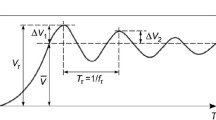Conclusions
The lower limit of the range of the transducer of p is given by the permissible reduction in the device sensitivity due to convection at low flow velocities while the upper limit is given by a reduction in the thermoanemometer sensitivity caused by an increased flow velocity. The static characteristic of the instrument is to a considerable extent nonlinear because of the nonlinearity of the thermoanemometer.
The transducer time constant is the resultant of two components: of the time constant of the chamber and channel (pneumatic component) and the time constant of the thermoanemometer (thermal component). In the case of correctly selected chamber and channel components the time constant of the thermoaneommeter may be assumed to remain constant over the entire measurement range, being dependent only on the dynamic properties of the selected thermistor and on the coefficient of negative feedback in the system T=const. The time constant of the penumatic part of the instrument is determined by the upper and lower limits of the thermoanemometric device measuring p at the given sensitivity threshold of the thermoanemometer.
The temperature and density errors of the transducer are large and necessitate the use of special compensating devices if the instrument is to be used over a wide temperature and pressure range.
Similar content being viewed by others
Literature cited
V. A. Ferenets, Author's Certificate No. 164,165, Byull. Izobr. No. 14 (1964).
N. P. Udalov, Semiconductor Sensors [in Russian], Énergiya, Moscow-Leningrad (1965).
L. A. Zalmanzon, Elements Carrying the Flow in Pneumatic Measurement and Control Devices [in Russian], Izd. AN SSSR, Moscow (1959).
A. G. Shashkov, Thermistors and Their Use [in Russian], Énergiya, Moscow (1967).
G. P. Katys, Automatic Systems for Controlling Velocity Fields and Flow Rates [in Russian], Nauka, Moscow (1965).
V. A. Besekerskii, Theory of Automatic Control Systems [in Russian], Nauka, Moscow (1966).
N. S. Afanas'eva, “Determination of the Coefficient of Inertia of Semiconductor Thermistors and a Flow Velocity Sensor, in: Semiconductor Thermistors [in Russian], Gosénergoizdat, Moscow-Leningrad (1959).
Additional information
Translated from Izmeritel'naya Tekhnika, No. 1, pp. 45–48, January, 1973.
Rights and permissions
About this article
Cite this article
Safonov, O.A., Osvetimskii, A.A. Thermoanemometric transducer of pressure derivative. Meas Tech 16, 69–73 (1973). https://doi.org/10.1007/BF00816690
Issue Date:
DOI: https://doi.org/10.1007/BF00816690




